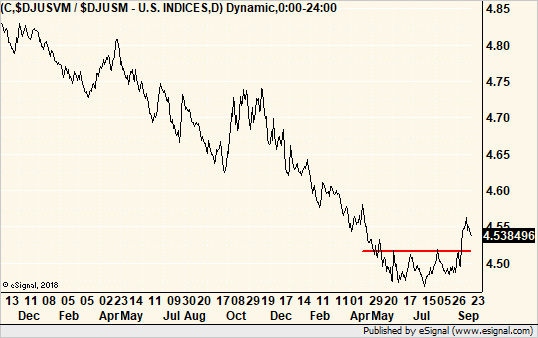The Smart Money Is Looking for Value Stocks
A long-overdue rotation into value appears to finally be underway


September shaped up to be a pivotal month for stocks – and perhaps, specifically, value stocks.
For starters, it wasn’t the bear of a month we usually expect. On average over the past half-century, September is the only month to produce a significant negative average return. This year, September was nicely positive. Major market indexes, such as the Standard & Poor’s 500, finished the month near all-time highs.
But the noteworthy event was a little more specific. Between Sept. 5 and Sept. 16, as the S&P 500 gained 2.0%, the “smart money’s” focus shifted. Value stocks were suddenly in demand – at the expense of growth stocks.
From just $107.88 $24.99 for Kiplinger Personal Finance
Become a smarter, better informed investor. Subscribe from just $107.88 $24.99, plus get up to 4 Special Issues

Sign up for Kiplinger’s Free Newsletters
Profit and prosper with the best of expert advice on investing, taxes, retirement, personal finance and more - straight to your e-mail.
Profit and prosper with the best of expert advice - straight to your e-mail.
Where Growth Started Showing Its Cracks
Let’s look at what was happening outside the market to gain perspective.
On Sept. 5, progress in trade talks with China sparked a rally in the broader stock market. Of course, those talks have been on-again, off-again for months. But for that day, conditions were ripe for any spark to break the market out from its five-week trading range.
That same day, yields on long-term Treasury securities reversed their trends and started to move higher, providing some relief on the yield curve. You see, an inverted yield curve, where short-term rates are higher than long-term rates, is a big problem for financial-sector earnings. Banks borrow at lower short-term rates and lend at higher long-term rates; the difference between the two makes up most of their profits. Thus, financial stocks took the rise in long-term rates as a cue to break out to the upside, and they actually started to outperform the S&P 500.
Some of that steam was let out thanks to weak economic data across the first week of October. But now, it appears likelier that the Federal Reserve will again cut short-term rates. So the yield-curve roadblock is gone, at least temporarily. Banks and other financials could continue to outperform.
It appeared that momentum-driven growth sectors of the market, including technology, were about to give way to value sectors such as financials.
And on Sept. 9, we finally saw a breakout in value stocks relative to growth.

The chart above shows the ratio of mid-cap value stocks (via the Dow Jones US Mid Cap Value Index, listed here as $DJUSVM) to mid-cap growth stocks (Dow Jones US Mid Cap Growth Index, $DJUSGM).
We’ve seen such surges before. This time, given both chart-based indicators showing the shift and economic indicators suggesting a softening, it appears the smart money started to believe growth stocks were a bit too “crowded.”
Crowded is a fancy way to say that if everyone is bullish on something, theoretically everyone who’s going to buy it has already done so. With no one left to buy, the path of least resistance becomes lower. And in this case, if there’s no one left to buy growth stocks, the path of least resistance for value stocks becomes higher.
What Value Stocks’ Rise Means for Investors
This, like many things, is not an all-out buy or sell signal. But it does warrant reconsidering how your portfolio is constructed.
Any time one part of the market moves from laggard to leader, investors should pay attention. If value stocks take the lead, a higher portion of your portfolio should be invested there. If growth truly loses favor, consider lightening up there.
Did you notice what happened to Netflix (NFLX), one of the market’s leading superstars? It’s crumbling (relatively speaking). While the market is up 16% in 2019, Netflix is flat – courtesy of a 29% decline over the past three months.
Momentum stocks can, and do, fall back to earth.
But there is one more important implication for this shift. Pundits call it a “rotation” from one area to another. And usually, it is an overall good sign for the bulls.
Rotation is simply when one leadership group yields to another. The important thing is: As long as another group actually leads the market higher, it is a healthy change. There’s only a problem when leading groups stop leading, but no other group takes over. That would be a signal that a bull run is nearing its end.
In short: Investors are rotating away from higher-growth momentum stocks and rotating into overlooked value stocks. It makes sense. Momentum stocks garnered a lot of interest, but it made them expensive put them at higher risk for pullbacks. Value stocks, by comparison, were (and still are) much cheaper due to lack of demand.
Just compare the valuations of the iShares Russell 2000 Value ETF (IWN) to the iShares Russell 2000 Growth ETF (IWO). Value is trading at just 12.4 times its collective trailing 12-month profits. Growth is priced almost twice as high, at 24.6.
The takeaway? It’s not time to sell out growth completely. But it is time to make some changes in a stock market that still is holding its own, despite October’s opening fireworks.
Profit and prosper with the best of Kiplinger's advice on investing, taxes, retirement, personal finance and much more. Delivered daily. Enter your email in the box and click Sign Me Up.

-
 3 Major Changes to the Charitable Deduction in 2026
3 Major Changes to the Charitable Deduction in 2026Tax Breaks About 144 million Americans may qualify for the 2026 universal charity deduction, while high earners face new IRS limits. Here's what to know.
-
 Where to Stash Cash as Yields Fall, According to Advisers
Where to Stash Cash as Yields Fall, According to AdvisersYour best options depend on how soon you'll need the money and your tolerance for risk.
-
 Control vs Protection Quiz: Which Trust Do You Need?
Control vs Protection Quiz: Which Trust Do You Need?Quiz Take this simple quiz to discover whether a revocable or irrevocable trust should be the cornerstone of your estate plan.
-
 If You'd Put $1,000 Into 3M Stock 20 Years Ago, Here's What You'd Have Today
If You'd Put $1,000 Into 3M Stock 20 Years Ago, Here's What You'd Have TodayMMM stock has been a pit of despair for truly long-term shareholders.
-
 Nasdaq Sinks 418 Points as Tech Chills: Stock Market Today
Nasdaq Sinks 418 Points as Tech Chills: Stock Market TodayInvestors, traders and speculators are growing cooler to the AI revolution as winter approaches.
-
 Stocks Slip to Start Fed Week: Stock Market Today
Stocks Slip to Start Fed Week: Stock Market TodayWhile a rate cut is widely expected this week, uncertainty is building around the Fed's future plans for monetary policy.
-
 Stocks Keep Climbing as Fed Meeting Nears: Stock Market Today
Stocks Keep Climbing as Fed Meeting Nears: Stock Market TodayA stale inflation report and improving consumer sentiment did little to shift expectations for a rate cut next week.
-
 If You'd Put $1,000 Into Coca-Cola Stock 20 Years Ago, Here's What You'd Have Today
If You'd Put $1,000 Into Coca-Cola Stock 20 Years Ago, Here's What You'd Have TodayEven with its reliable dividend growth and generous stock buybacks, Coca-Cola has underperformed the broad market in the long term.
-
 If You Put $1,000 into Qualcomm Stock 20 Years Ago, Here's What You Would Have Today
If You Put $1,000 into Qualcomm Stock 20 Years Ago, Here's What You Would Have TodayQualcomm stock has been a big disappointment for truly long-term investors.
-
 If You'd Put $1,000 Into Home Depot Stock 20 Years Ago, Here's What You'd Have Today
If You'd Put $1,000 Into Home Depot Stock 20 Years Ago, Here's What You'd Have TodayHome Depot stock has been a buy-and-hold banger for truly long-term investors.
-
 Stocks Close Out Strong Month With Solid Amazon Earnings: Stock Market Today
Stocks Close Out Strong Month With Solid Amazon Earnings: Stock Market TodayAmazon lifted its spending forecast as its artificial intelligence (AI) initiatives create "a massive opportunity."